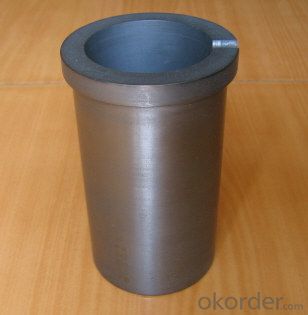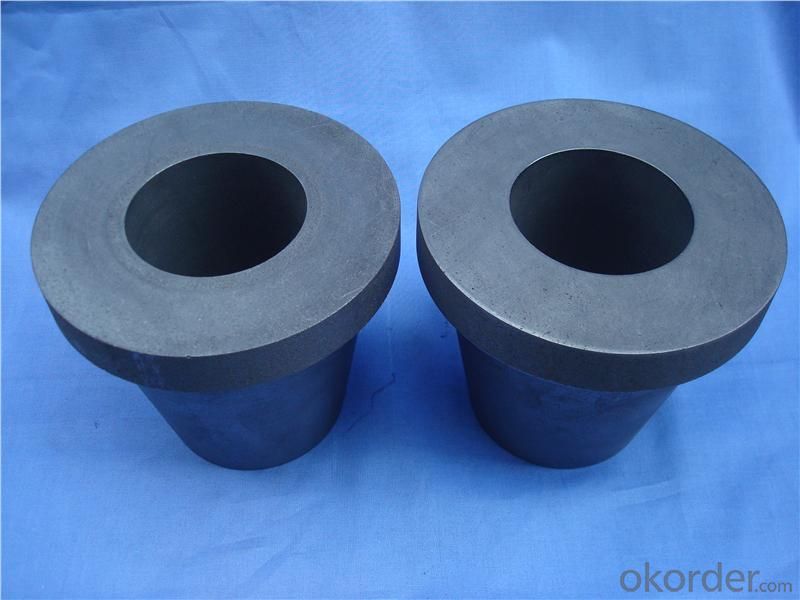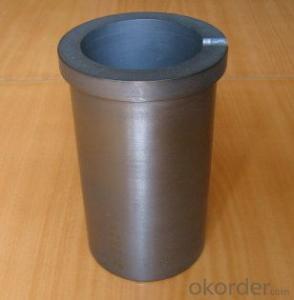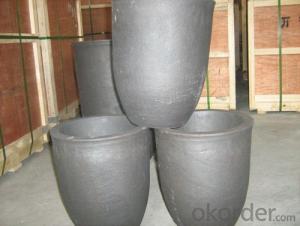Graphite Crucible High Purity CNBM China
- Loading Port:
- China main port
- Payment Terms:
- TT OR LC
- Min Order Qty:
- 0 m.t.
- Supply Capability:
- 100000 m.t./month
OKorder Service Pledge
OKorder Financial Service
You Might Also Like
Packaging & Delivery
| Packaging Details: | wooden box,usually according to detailed product. |
| Delivery Detail: | Within 35 days after payment |
Features
1.Long working lifetime: its working lifetime is increased 3-5 times over normal clay-crucible due to the compact body formed under high pressure.
2.High thermal conductivity: high-density body and low apparent porosity greatly improve its heat conductivity.
3.New-style materials: new heat conduction material ensures faster heat conductivity and pollution-free product, reduces adherent slag.
4.Resistance to corrosion:better anti-corrosion than normal clay-crucible.
5.Resistance to oxidation: advanced process dramatically improves its oxidation resistance, which ensures persistent heat conductivity and long working lifetime.
6.High-strength: high-density body and logical structure make the product better compression property.
7.Eco-friendly: energy-efficient and pollution-free, not only ensure metal product purity, but also ensure sustainable development on environment.
8.Multi-function: Can be used in induction graphite crucible furnace
Specification
Bulk Density | g/cc | 1.70-1.88 |
Specific Resistance | μΩ.m | 6.0-15.0 |
Compressive Strength | MPa | 30-80 |
Bending Strength | MPa | 20-45 |
Shore hardness | 30-70 | |
C.T.E.(100-600°C) | x10-6 /°C | 2.5-5.5 |
Ash | % | 0.01-0.2 |
Maximum Grain Size | mm | 0.044-0 |
Our services
Close customer contact through a global marketing network covering more than 90 countries
Professional technical and individual advice provided at customers‘ own sites
Detailed design proposals to solve customer-specific problems
Application-oriented training in key applications and special literature
Extensively equipped laboratories for analyses
Reliable and flexible delivery service
We can manafacture and export graphite electrodes in different grade ,shape and dimension.Whenever you need it ,please feel free to let us know.we promise you the top quality and lower price.
Picture



- Q:What is carbon offsetting in the hospitality industry?
- Carbon offsetting in the hospitality industry refers to the practice of counterbalancing the greenhouse gas emissions produced by hotels, resorts, and other hospitality businesses. It is a way to compensate for the carbon footprint created by various activities within the industry, such as energy consumption, transportation, waste management, and water usage. The process of carbon offsetting involves calculating the amount of carbon dioxide or other greenhouse gases emitted by a hospitality establishment and then investing in projects that reduce emissions elsewhere. These projects can include renewable energy initiatives, reforestation efforts, or energy efficiency programs. By supporting such projects, the hospitality industry aims to neutralize or offset its own carbon emissions, effectively reducing its impact on climate change. Hotels and resorts can choose to purchase carbon offsets from specialized organizations that facilitate carbon offset projects. These organizations ensure that the offsets are verified and comply with recognized standards, such as the Verified Carbon Standard or the Gold Standard. By investing in verified offsets, the hospitality industry can have confidence that their contributions are making a real and measurable difference in reducing global greenhouse gas emissions. Carbon offsetting in the hospitality industry is not only a way to demonstrate environmental responsibility, but it can also have economic benefits. Many travelers are becoming increasingly conscious of the environmental impact of their accommodation choices and are actively seeking out hotels and resorts that prioritize sustainability. By implementing carbon offsetting programs, hospitality businesses can attract environmentally conscious guests and differentiate themselves in a competitive market. Furthermore, carbon offsetting is just one part of a broader sustainability strategy within the hospitality industry. Many hotels and resorts are also adopting energy-efficient practices, implementing waste reduction measures, and promoting water conservation. By combining these efforts with carbon offsetting initiatives, the hospitality industry can contribute to a more sustainable future while also improving their bottom line. In summary, carbon offsetting in the hospitality industry involves investing in projects that reduce greenhouse gas emissions to compensate for the carbon footprint created by hotels and resorts. It is a way to neutralize the environmental impact of the industry and demonstrate a commitment to sustainability. By implementing carbon offsetting programs, the hospitality industry can attract environmentally conscious guests, differentiate themselves in the market, and contribute to a more sustainable future.
- Q:What are the consequences of increased carbon emissions on tourism industry?
- The tourism industry is greatly affected by the significant consequences of increased carbon emissions. One prominent result is the deterioration of natural landscapes and ecosystems that attract tourists. Carbon emissions contribute to global warming, which leads to higher temperatures, melting glaciers, and more frequent extreme weather events like hurricanes and droughts. These environmental changes can cause the destruction of iconic landmarks, such as coral reefs or national parks, which are often the main attractions for tourists. Additionally, increased carbon emissions contribute to air pollution, which can have negative effects on air quality in popular tourist destinations. This poor air quality can lead to respiratory problems and other health issues for both tourists and local populations, making these places less desirable to visit. Moreover, the degradation of natural environments due to carbon emissions can also harm wildlife, resulting in a decline in biodiversity. This loss of wildlife can reduce the appeal of ecotourism destinations, which heavily rely on diverse flora and fauna. Furthermore, the tourism industry heavily depends on transportation, which is a major source of carbon emissions. The use of fossil fuels in planes, ships, and cars contributes to the industry's overall carbon footprint. As countries strive to decrease their carbon emissions, they may enforce stricter regulations or impose taxes on air travel, making it more expensive and less accessible for travelers. This can impact the number of tourists visiting different destinations and impede the growth of the tourism industry. Lastly, the consequences of increased carbon emissions extend beyond environmental factors. Climate change and extreme weather events can disrupt travel plans, resulting in cancellations and financial losses for both tourists and businesses in the tourism industry. Additionally, destinations that heavily rely on winter tourism, like ski resorts, may face challenges due to shorter snow seasons or inconsistent snowfall patterns caused by climate change. In conclusion, increased carbon emissions have dire consequences on the tourism industry. From the degradation of natural landscapes and ecosystems to the impact on air quality and wildlife, the effects of carbon emissions can discourage tourists from visiting certain destinations. Furthermore, the industry's reliance on transportation contributes to its overall carbon footprint, potentially leading to increased costs and limited accessibility for travelers. Climate change-related disruptions and financial losses further exacerbate the challenges faced by the tourism industry.
- Q:Buy carbon carving, how to identify him is true or false, and the quality of good or bad?
- General consumers believe that bamboo charcoal, powder, charcoal and purple carbon carving are "carbon" to do, and the former is very cheap, why not buy them, in fact, otherwise, because not the same kind of products. Bamboo charcoal and powdered activated carbon have little effect on the purification of indoor air. Their function is not different from that of a pack of quicklime - adsorption of water vapor. But consumers are not aware of this, they also propaganda have the function of purifying air and we mixed together to sell, finally, once consumers buy found not what role, will also lose confidence in carving, which makes us very sad.Let's talk about bamboo charcoal first. Charcoal is not a purple carbon carving, this is a common sense. If bamboo charcoal can also absorb toxic and harmful gases, then the main material of gas masks do not need to use more expensive activated carbon, but not sublimation of purple carbon carving, and the price of bamboo charcoal is not economical? Because the bamboo charcoal and charcoal are natural burning carbon, not activated by directional adsorption, namely, pickling, washing, activation process, the adsorption of activated carbon 1/10 is insufficient, they can have is to adjust the indoor temperature, not only this, as they advertised "bamboo charcoal is activated carbon is purple carbon carving".Say, powdered activated carbon.
- Q:What is carbon PC?
- Polycarbonate (PC), polycarbonate is a molecular chain containing [O-R-O-CO] chain thermoplastic resin according to the molecular structure of the ester can be divided into aliphatic, alicyclic and aromatic type of fat, which has the practical value of the aromatic polycarbonate, and bisphenol A polycarbonate as the most important, molecular weight is usually 3-10 million.Polycarbonate, English Polycarbonate, referred to as PC.PC is a kind of amorphous, odorless, non-toxic, highly transparent colorless or slightly yellow thermoplastic engineering plastics, has excellent physical and mechanical properties, especially excellent shock resistance, tensile strength, bending strength, compressive strength and high creep; small size is stable; good heat resistance and low temperature resistance, mechanical properties, stability in a wide range of temperature dimensional stability, electrical properties and flame retardant properties, can be used for a long time at -60~120 deg.c; no obvious melting point, a molten state at 220-230 DEG C; the molecular chain rigidity, melt viscosity and high water absorption resin; small, small shrinkage, high precision, good dimensional stability, permeability of films is small; self extinguishing materials; stable to light, but not UV resistance, good weather resistance; oil resistance, acid and alkali resistance, no oxygen acid and amine, Ketones are soluble in chlorinated hydrocarbons and aromatic solvents. They are easy to cause hydrolysis and cracking in water for a long time. Because of their poor fatigue resistance, they are prone to stress cracking, poor solvent resistance and poor wear resistance
- Q:How does carbon impact the availability of freshwater resources?
- The availability of freshwater resources is impacted by carbon in several interconnected ways. Climate change is one of the primary means through which carbon affects freshwater availability. The burning of fossil fuels and other human activities result in increased levels of carbon dioxide in the atmosphere, which contributes to global warming. This warming, in turn, leads to changes in precipitation patterns, including alterations in rainfall distribution and intensity. The emission of carbon also leads to warmer temperatures, which can cause higher rates of evaporation and more frequent and severe droughts in specific regions. These droughts reduce the amount of water accessible for freshwater resources like rivers, lakes, and reservoirs. Furthermore, the shifting climate can disrupt natural water cycles, impacting the replenishment of groundwater aquifers, which are essential sources of freshwater. Moreover, the quality of freshwater resources is impacted by carbon. The increased carbon emissions reacting with atmospheric moisture result in acid rain, which acidifies freshwater bodies and renders them unsuitable for many aquatic organisms. This disruption to ecosystems can lead to the loss of species that depend on freshwater resources for their survival. Another manner in which carbon affects freshwater availability is through its influence on land use. The conversion of forests and wetlands into agricultural or urban areas releases carbon stored in vegetation and soil. This not only adds to carbon emissions but also diminishes the ability of natural ecosystems to retain and filter water. Forests, for instance, play a crucial role in maintaining the water cycle by absorbing rainfall and gradually releasing it into streams and groundwater. Deforestation disrupts this process and can result in reduced water availability downstream. In conclusion, carbon emissions have a profound impact on the availability of freshwater resources. Through climate change, carbon alters precipitation patterns, resulting in droughts and decreased water availability. It also affects the quality of freshwater through phenomena like acid rain. Moreover, land-use changes driven by carbon emissions can further diminish freshwater availability by disrupting natural water cycles.
- Q:What are the meanings of carbon, graphite, burr, two cuts and four cuts in steel?.
- Carbon element; carbon is carbon steel, round steel, Primeton is end of carbon steel, which is common round, is construction steel.
- Q:What is the carbon footprint of different activities?
- The carbon footprint of different activities refers to the amount of greenhouse gas emissions, particularly carbon dioxide, that are produced as a result of those activities. It varies depending on the type and scale of the activity. Activities such as driving a car, flying, using electricity, and consuming meat and dairy products typically have higher carbon footprints compared to activities such as walking, cycling, using renewable energy, and eating plant-based foods. The carbon footprint of an activity is an important measure to assess its environmental impact and to make informed choices towards reducing our carbon emissions.
- Q:How does carbon cycle through the environment?
- Carbon moves between the atmosphere, land, oceans, and living organisms in a continuous cycle known as the carbon cycle. This cycle is essential for maintaining a stable climate and supporting life on Earth. To begin, carbon dioxide (CO2) in the atmosphere is absorbed by plants during photosynthesis. Plants convert CO2 into organic carbon compounds, such as sugars and carbohydrates, which they use for growth and energy. Animals then consume these plants or other animals, passing the carbon along the food chain. When plants and animals die or excrete waste, their organic matter decomposes, releasing carbon back into the environment. Microorganisms, like bacteria and fungi, break down the organic matter and release carbon dioxide as a byproduct. Some carbon can be stored in the soil for long periods, depending on factors like temperature and moisture. This stored carbon in the soil may be released back into the atmosphere through processes like microbial respiration or erosion. Fossil fuel burning, including coal, oil, and natural gas, is another way carbon returns to the atmosphere. When these fuels are burned for energy, they release carbon dioxide, contributing to the greenhouse effect and climate change. The oceans also play a vital role in the carbon cycle. They absorb a significant amount of carbon dioxide from the atmosphere through carbon sequestration. Marine plants, like phytoplankton, also photosynthesize and store carbon in their tissues. When these organisms die, they sink to the ocean floor, where the carbon can be stored as sediment or dissolved in the water for long periods. Oceanic circulation and biological processes redistribute carbon throughout the oceans, with surface water exchanging carbon with the atmosphere. Furthermore, the oceans act as a carbon sink, storing large amounts of carbon dioxide and helping to regulate its levels in the atmosphere. In conclusion, the carbon cycle is a complex and interconnected process involving various natural and human activities. Understanding and managing this cycle is crucial for mitigating climate change and maintaining a healthy environment.
- Q:How does carbon impact the prevalence of heatwaves?
- Carbon impacts the prevalence of heatwaves by contributing to the greenhouse effect. When carbon dioxide and other greenhouse gases are released into the atmosphere, they trap heat from the sun, leading to a rise in global temperatures. This increase in temperature makes heatwaves more frequent, intense, and longer-lasting, posing significant risks to human health, ecosystems, and infrastructure.
- Q:In Japanese, what's the difference between adding "carbon" and "sauce" after the name?
- Japanese in the name behind the general "San" (similar to the Chinese pronunciation: Mulberry) respect.This "carbon" was originally a child to say the "San" (sang) the time because the enunciation is not very clear, so it is easy to say "carbon".
1. Manufacturer Overview |
|
|---|---|
| Location | |
| Year Established | |
| Annual Output Value | |
| Main Markets | |
| Company Certifications | |
2. Manufacturer Certificates |
|
|---|---|
| a) Certification Name | |
| Range | |
| Reference | |
| Validity Period | |
3. Manufacturer Capability |
|
|---|---|
| a)Trade Capacity | |
| Nearest Port | |
| Export Percentage | |
| No.of Employees in Trade Department | |
| Language Spoken: | |
| b)Factory Information | |
| Factory Size: | |
| No. of Production Lines | |
| Contract Manufacturing | |
| Product Price Range | |
Send your message to us
Graphite Crucible High Purity CNBM China
- Loading Port:
- China main port
- Payment Terms:
- TT OR LC
- Min Order Qty:
- 0 m.t.
- Supply Capability:
- 100000 m.t./month
OKorder Service Pledge
OKorder Financial Service
Similar products
New products
Hot products
Related keywords



























